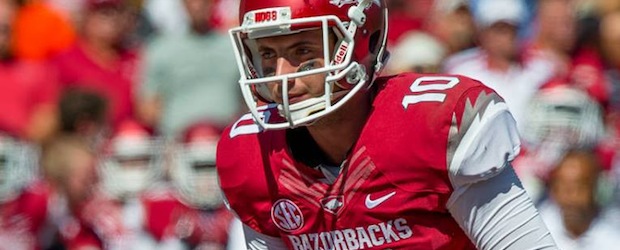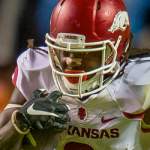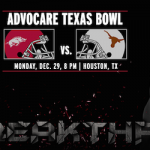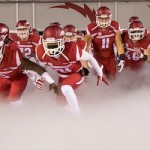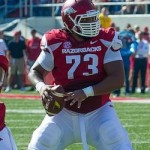All Eyes Are on Brandon Allen’s Shoulder
Every Razorback beat writer, fan, and sports-injury junkie is trying to determine exactly what is wrong, if anything, with quarterback Brandon Allen’s shoulder.
The sophomore quarterback took a dive into the end zone on the first scoring drive for the Razorbacks Saturday in Fayetteville against the University of Southern Mississippi Golden Eagles. The score, drop and roll seemed harmless enough, but something happened on the play to send Allen to the locker room, and later to put him in street clothes on the sideline with his arm in a black sling.
“I don’t have any information other than it didn’t appear to be anything more than a … bruise,” Razorback head football coach Bret Bielema said in a press conference following Saturday’s game. “Didn’t want to put him back in today. It’s still a bit tender.
“But he seems pretty convinced he’ll be back by the start of next week (meaning the week of Sept. 19),” Bielema said. ” So, we’ll see where that goes.”
Here is where it goes as of Monday, Sept 19.
From Kurt Voight of the Associated Press reported:
Bret Bielema still doesn’t know whether Brandon Allen will play this week, and he’s not about to put any more information out there about the quarterback’s status than he needs to.
…
Backup quarterback AJ Derby finished the game, and Bielema said the junior will prepare with the first-team offense this week while he awaits definitive word on Allen’s status.
“It’s really just a matter of how fast (Allen’s) body can heal,” Bielema said. “I know it’s a throwing arm issue … I wouldn’t want to put him in harm’s way at all.”
…
To help the Razorbacks quarterbacks focus on Saturday’s game, Bielema said he’s making them “off limits” to interviews this week.
Bielema was quoted as saying Allen thinks he can play Saturday but the medical staff says no.
Rumors and reports and whispers range from Allen plays Saturday to he is out this weekend against Rutgers to he is out for weeks.
What we know for sure is what has been said by the coach. What we also know is how the shoulder works, typical sports-medicine injuries that can occur to the shoulder, how the injuries are repaired and standard recovery times.
First, let’s take a closer look at the shoulder and how it works.
The shoulder is one of the most complex joints in the body and also one of the most easily injured.
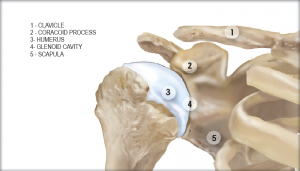 It is a ball-and-socket joint, much like the hip, and allows for the greatest range of motion of all the joints in the human body. The shoulder is comprised of three major bones including: the humerus (arm bone); scapula (shoulder blade); and the clavicle (collarbone). The top of the humerus is the ball of this ball-and-socket joint. It is covered in a layer of cartilage that cushions its movement within the glenoid cavity, the socket of the joint.
It is a ball-and-socket joint, much like the hip, and allows for the greatest range of motion of all the joints in the human body. The shoulder is comprised of three major bones including: the humerus (arm bone); scapula (shoulder blade); and the clavicle (collarbone). The top of the humerus is the ball of this ball-and-socket joint. It is covered in a layer of cartilage that cushions its movement within the glenoid cavity, the socket of the joint.
The clavicle attaches the shoulder to the rib cage and secures its position away from the body. The scapula is the larger, triangular bone on the posterior side of the joint.
These bones are held together by an assortment of muscles, tendons and ligaments called the rotator cuff. These muscles and tendons connect the bones as well as hold the ball of the upper arm securely in the shoulder socket.
Shoulder instability occurs when the structures surrounding the ball-and-socket shoulder joint become too loose to secure the stability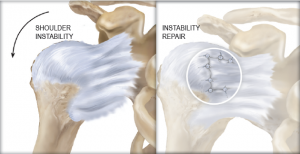 of the joint. If the joint becomes too loose it may slide partially out of place. This condition is called shoulder subluxation.
of the joint. If the joint becomes too loose it may slide partially out of place. This condition is called shoulder subluxation.
If the joint becomes completely separated due to damage to the tendons, it is called shoulder dislocation. After a dislocation the tendons of the shoulder will not heal together tightly and will be prone to dislocation in the future.
Patients who suffer from shoulder instability often experience pain with activities and a sensation that their shoulder may become dislocated.
Depending on the severity, this condition can be treated with rehabilitation and physical therapy. Strength training exercises may be able to help restore some of the stability in the shoulder. If all else fails, arthroscopic shoulder surgery may be the answer to get you back to the daily activities you enjoy.
There is much medical research on shoulder instability and dislocation in athletes. One roundup of such studies reports:
Does participation in athletics increase the risk of recurrence? Common sense would say that placing the arm in abduction and external rotation in a contact sport such as basketball or playing a collision sport such as football would likely increase the recurrence risk. The literature has varied on this topic, however the question may not be that important.
[One study showed] a 41% recurrence risk in athletes returning to play in-season and showed no increased risk with football as compared to noncollision sports. This is in contrast to [another] study … reporting an 82% recurrence risk in young athletes versus 30% in nonathletes of the same age group.
The report says athletes in the study who were treated non-surgically for shoulder dislocation injuries returned to the sport in an average of 10-11 days, although many sustained the injury again during the same season. Athletes who had surgery to repair the instability missed an average of 4.5 months.
According to the report: “Three basic options exist for treatment of the in-season athlete with an acute shoulder dislocation: 1) attempt to complete the season with or without a brace and defer surgery until they have a recurrence of instability, 2) attempt to complete the season with or without a brace and defer surgery until the off-season, 3) immediate surgery and forfeit the current season. Each scenario has its own obvious advantages and disadvantages.”
The non-surgical options for a dislocated shoulder include:
Rehabilitation: Hard work and concentrated strengthening exercises can build up the muscles of the rotator cuff, which can help to regain stability and normal shoulder function.
Pain medications: Medications such as acetaminophen and non-steroidal anti-inflammatory drugs (NSAIDs) can offer pain relief and reduce swelling in an injured joint.
Cortisone injections: Cortisone injections can greatly reduce pain and inflammation in the shoulder and allow a patient to begin physical therapy.
Apply ice and heat: Using ice packs can help reduce pain and inflammation in the joint. Apply an ice pack for 15 to 20 minutes at a time multiple times each day. Once the pain has improved, heat is applied to relax the muscles.
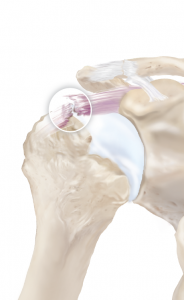 Another common shoulder injury is a rotator cuff tear, which is damage to the tendons that hold the bones of the shoulder joint together.
Another common shoulder injury is a rotator cuff tear, which is damage to the tendons that hold the bones of the shoulder joint together.
A rotator cuff injury is usually linked to injuries caused by direct trauma, or by repetitive motions such as lifting and sports that require the arms to be raised above the head such as baseball, swimming and tennis.
SYMPTOMS OF A ROTATOR CUFF INJURY INCLUDE:
• Tenderness in the shoulder when reaching
• Weakness in the shoulder
• Decreased range of motion
• Pain over the outside of the shoulder and sometimes running down the arm to the elbow
• Difficulty sleeping on the affected shoulder
While most rotator cuff tears will not heal on their own, there are many non-surgical tactics one can take to ease the pain and discomfort caused by the injury. It can take weeks to months for a rotator cuff tear to heal, with or without surgery.
It is important to note a sling, similar to the one worn by Brandon Allen, is commonly used to stabilize most shoulder injuries.
Again, right now, we are told Brandon Allen’s shoulder injury doesn’t “appear to be anything more than bruise,” but as the days or weeks go by, any missed playing time will give clues as to what the injury is or could be.


